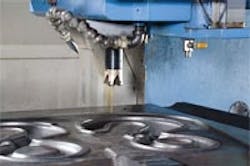In 1956, the Crosby Group added lebus to its manufacturing stable. the name was familiar in the Texas oil fields as a provider of load binders, snatch blocks, and tail chains. the quality and reputation made lebus the center of Crosby’s forging work.
Today, the plant in Longview, TX, uses extensive quality control systems and the latest technology to prepare high volumes of dies needed in the forge shop. Lebus also boasts heat-treating furnaces it uses to normalize and quench-andtemper products.
In order to maintain a steady pace of reconditioning its worn dies, Crosby-Lebus looked to its partnership with Ingersoll Cutting Tools for a two-step process: a visit from its field representative Ernie Schooley, and attending tooling seminars at Ingersoll’s Rockford, IL, headquarters.
Schooley makes regular visits to Longview, and they have resulted in several improvements. Last March during a general evaluation, an improvement in deck-surface reconditioning arose from a problem that Crosby-Lebus wasn’t aware they had. Its conventional zero-rake indexable finishing face mill was providing a 15-IPM feed rate, which was satisfactory. At that time, Schooley provided a new Hi-Pos Deka face mill for Crosby-Lebus to evaluate, which they did, theough they never targeted an application or pushed the feed.
Six weeks later at a seminar in Rockford, CNC machinist Sidney Maxwell saw that the Hi-Pos Deka cutter feeding at 150 IPM on the same stock they were running back at Longview. The ability to increase milling tenfold was right there in the shop. Upon his return from the seminar, Maxwell set up a trial on a “live” repair job with Schooley and the two were able to reach the same result as Maxwell saw in Rockford. It was with the same cutter and pitch as before (2-in. diameter, 5 inserts), but the difference was with the cuttingedge geometry.
“Although the cutters were the same size and pitch, the Hi-Pos Deka cutter has a positive rake, not zero as before,” said Schooley, referring to the existing system that was in place. “Moreover, a large wiper flat behind the cutting edge ‘burnishes’ the newly machined area to maintain a good surface finish despite the higher feed. And the inserts are thicker than the ones used before, and therefore stronger.”
The inserts also provide ten indexable cutting edges, versus four in the previous set-up. This reduces the insert inventory requirement, cutting back on expenses and extending tool life.
“Retooling this skin milling process triggered a widespread improvement in the die shop and beyond, since every dieset in for repair undergoes this process,” said programmer Buddy Walston. Faster skin milling also created the potential to redistribute the operations over equipment in the shop to improve economics and turnaround further.
Another walk-through a couple weeks later resulted in a retooling of the actual die sinking operation, cutting cycle time in half and eliminating all subsequent hand polishing.
The original process involved re-cutting the cavity with a standard solid carbide ball mill, followed by an hour of manual polishing. Maxwell, Walston, and Schooley changed to a -in. Ingersoll Chip-Surfer “high-feed” cutter with a replaceable tip — a process demonstrated at the same Rockford seminar where the Hi-Pos Deka was demonstrated. The trio ran the trials with the new chip-surfer cutter in May, and by July it was standard practice for applications including gutters and flash lands, as well as cavities themselves. The new process runs at 50 IPM feed, with a much lower stepover than the previous set up (30 IPM with a 0.030-0.050-in. stepover.)
The Chip-Surfer’s silhouette uses an extreme lead angle on the face, capitalizing on chip thinning. The corner blends into a backdraft angle, so there are far less radial forces to cause vibration. And, the tough alloy shank withstands shock and side deflection better than the more brittle solid carbide cutters. Machinists are able to change the tips right in the spindle, saving time and preserving all datum references.
“The tool design also recognizes that efficient cavity milling is essentially side milling, which involves higher lateral forces,” said Schooley. “The alloy tough shank handles lateral forces that would snap off a solid carbide cutter.”
Walston is pleased with the as-machined finish, proving to be good enough to eliminate polishing. “Mind you, we’re talking surface finishes on forging dies for hoist and crane parts, not precision plastic molds,” he said. “As an example, one of our forgings is a 40-in. crane hook with a 300 metric ton capacity rating.”
